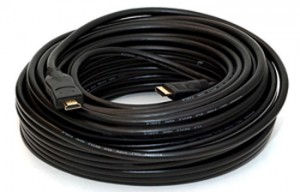One of the drawbacks of an HDMI cable is that they are not the best for long cable runs. Nonetheless, There are places that sell an efficient long HDMI cable (40ft and longer) that have been able to pass a 1080p signal in lab tests, one of which you can find here. In some circumstances, an equalizer was needed. I will provide you with the link to the location to get them at the end of this post.
So it is worth a shot, but outcomes will differ depending on the equipment becoming used. Not all pairs of devices are in a position to pass the signal over longer cable runs.
 The maximum length of cable that may be effectively employed varies depending on each individual cable, as well as the quality specs of the manufacturer. You will find 100ft thick wire gauge cables accessible with out a signal booster that some folks find to work well with their eqipment. Nonetheless, the only method to find out if they’ll work for you would be to attempt it your self.
The maximum length of cable that may be effectively employed varies depending on each individual cable, as well as the quality specs of the manufacturer. You will find 100ft thick wire gauge cables accessible with out a signal booster that some folks find to work well with their eqipment. Nonetheless, the only method to find out if they’ll work for you would be to attempt it your self.
So just how do you know if you have an HDMI cable that’s too lengthy? If there’s any problem with your HDMI cable, the signs will probably be really obvious. In most cases, you won’t get any picture at all as well as the screen will probably be blank. Otherwise, the image may flicker, or the pixels could drop out. In some instances you could only get sound to work with your gear. If any one of these difficulties occur together with your system, then the electronic signal transmission from your HDMI cable just isn’t strong enough.. What you can do at this point is either get a shorter HDMI cable, attempt a different cable with similar length and hope it works, or try a signal booster. Obviously, if at all possible, try out a smaller cable.
You can find equalizers produced for HDMI cables that can aid maintain the signal strength and high quality throughout the whole length of the lengthy HDMI cable. Some other titles for signal equalizers are signal enhancer and signal boosters, given that they improve the signal and cleans up interference. The actual image quality like color, and resolution just isn’t affected as a result of such devices.
It’s also possible to lengthen an HDMI cable run with the use of an HDMI extender over CAT5e or Cat6 cabling. These devices can extend the length of an HDMI cable run as much as 100 to 160 feet. They can also sustain a 1080p signal all through the run too as Support for DDC & HDCP.
Many people are now learning that HDMI is an “all or absolutely nothing” technology. Digital signals like HDMI will either have perfect video being displayed or a blank screen (defective cable). There’s no degradation of image quality like analog cabling. If your HDMI cable is not sending out a strong enough signal, you’ll get distinct video issues like distortion, flickering, or possibly a black screen. So give some of these options a attempt and you will probably get good results.